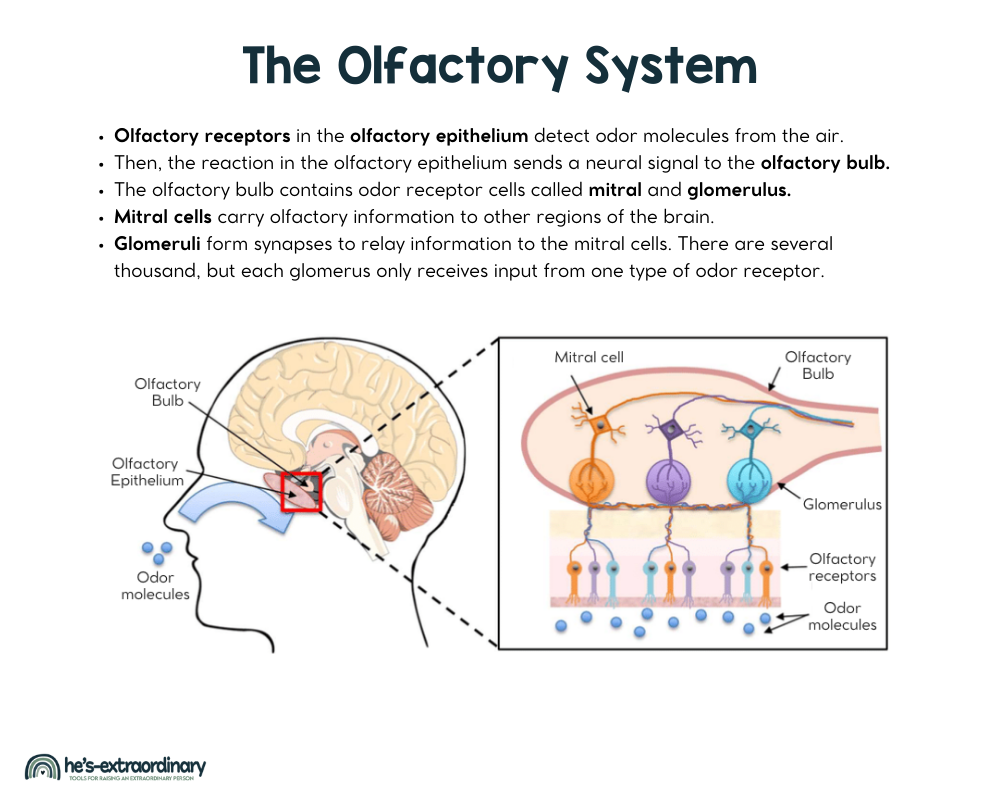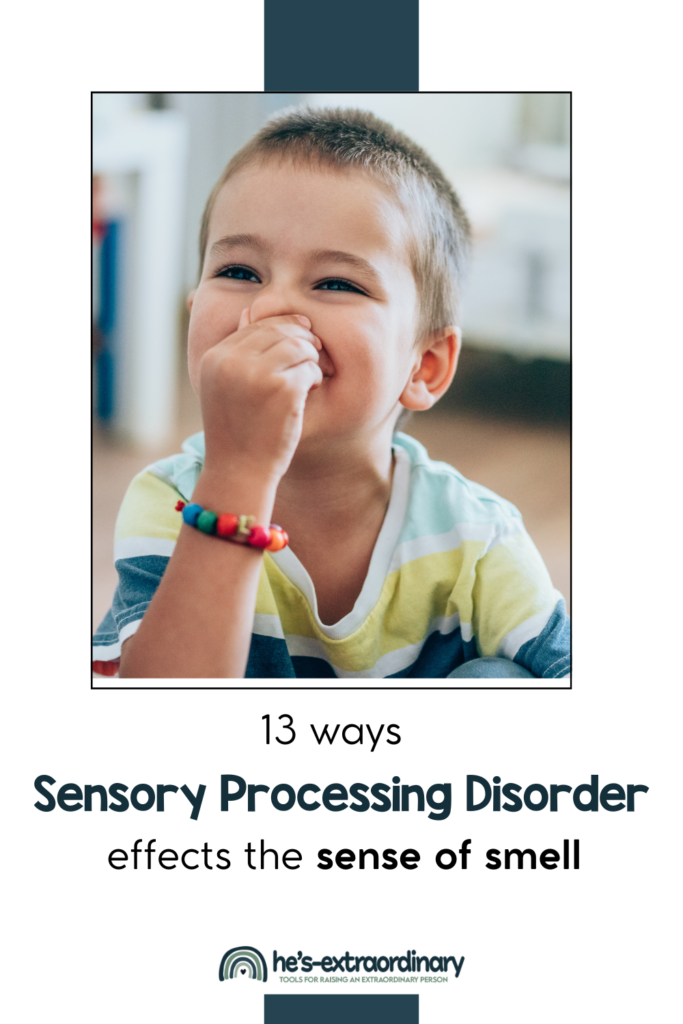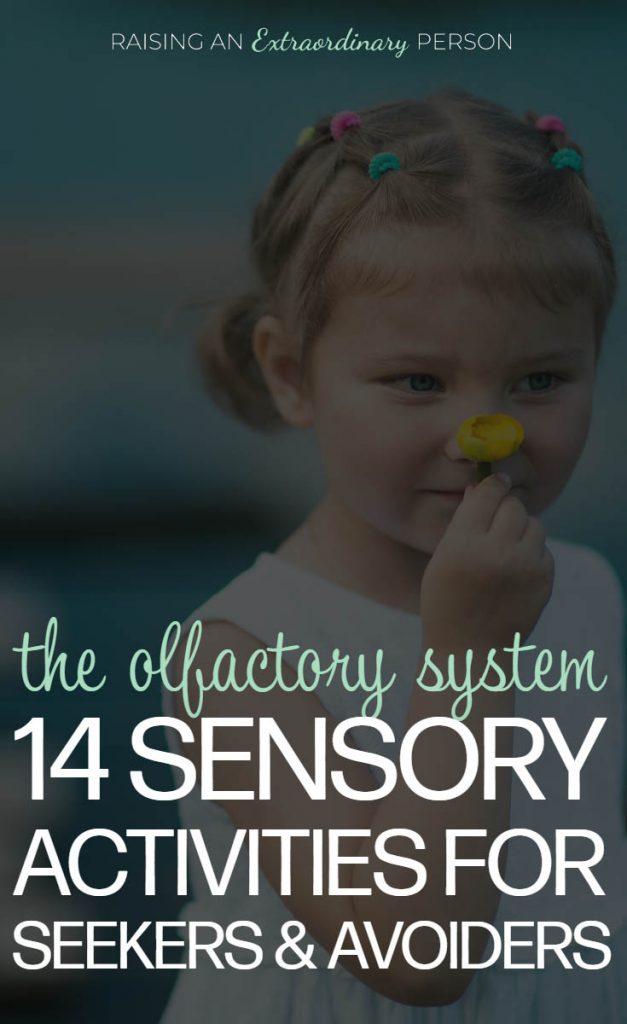The Olfactory System: How Does it Work & How It’s Impacted by SPD
What’s inside this article: A look at how the olfactory system (our sense of smell) works and how it’s impacted by SPD. Plus, a list of sensory activities and strategies to try with your child.
Disclaimer: This post contains affiliate links.
This post is part of a 10-part series on the sensory systems. Each part will contain a table of contents to help you easily navigate through the entire series.
Table of Contents:
- Introduction – The Sensory Spectrum
- The Tactile System
- The Auditory System
- The Visual System
- Proprioception
- Vestibular System
- Interoception
- The Olfactory System
- The Oral-Motor System
- Bilateral Coordination
What is The Olfactory System?
The olfactory system is most commonly referred to as our sense of smell.
The parts of the olfactory pathway are located inside the nose and connect to the olfactory cortex in the brain.
This system plays a significant role not only in the perception of different smells but also in the flavor of foods and emotional and memory-related responses to scents.
That’s why what we smell can affect behavior, emotion, memory, and thoughts.
How Does The Olfactory System Work?
The olfactory system, as well as the gustatory system (taste), is part of your chemo-sensory system. In other words, it senses chemicals or odor molecules.
When we breathe, olfactory receptors in the olfactory epithelium detect odor molecules from the air. These receptors are very small hair cells inside the nose that react to the odor molecules.
Then, the reaction in the olfactory epithelium sends a neural signal to the olfactory bulb. The olfactory bulb is located in the brain. It organizes and processes all odors. It’s also connected to various regions of the brain.
The olfactory bulb contains odor receptor cells
Mitral cells carry olfactory information processed by the olfactory bulb to other regions of the brain.
Glomeruli are spherical cells that form synapses to relay information to the mitral cells. There are several thousand Glomeruli cells in the olfactory bulb. Each glomerulus only receives input from one type of odor receptor.
All of these terms may sound confusing, but take a look at the diagram below to help you follow the olfactory pathway.

Atypical Sensory Processing Affects on Smell
Atypical olfactory processing can occur when there is an abnormal increase or decrease in the signals transmitted from the olfactory epithelium to the olfactory bulb.
It can also occur if sensory receptors or neurons transmit incorrect signals to the brain, causing you to smell things differently (often unpleasantly) or smell things that aren’t there.

Sensory Integration Issues Related to Olfactory Processing
The following are some of the common signs that your child is struggling with olfactory processing issues.
Sensory Discrimination or Perception Issues
Discrimination and perception issues occur when the brain is struggling to interpret and give meaning to sensory input.
- Olfactory discrimination issues usually go hand in hand with gustatory/oral discrimination issues (taste) because the two systems are very closely connected.
- Unable to identify odors or unable to identify the source of an odor
- Distorts odors – usually, when this happens, an odor that is pleasant to most people smells extremely unpleasant
Modulation Issues
Occurs when the brain over- or under-responds to sensory input.
Over-Responsive (Olfactory Defensiveness/Avoidance)
- Gags from certain smells even though others would consider it mild
- Avoids foods because of their smells
- Avoids public places because of many different smells
- Picky-eater either has a very limited diet, or prefers very bland foods
- Has told other people they stink
- Smells things that other people don’t because to others the smell is too subtle.
- Strong reactions and even aggression when around certain odors
Under-Responsive (Olfactory Seeking)
- Frequently smells people and objects
- Enjoys strong scents
- Doesn’t notice “dangerous” smells, for example, chemicals, gas, permanent markers, etc.
- Craves certain smells
Strategies for Managing Olfactory Processing Differences
For Over-Responsiveness:
- Respect your child’s odor sensitivities; although odors don’t bother you, it is very real and distressing
- Avoid strong perfumes, colognes, candles, scented waxes, etc.
- Use mildly scented or unscented cleaners, laundry detergents, hand soaps, etc.
- Make sure
you r child’s school allows them to move away from other students duringlunch if the smell of their food bothers them. - Avoid mixing odors – for example, burning a vanilla-scented candle while also preparing a stir fry with Asian seasonings.
For Under-Responsiveness
- Use essential oils in your home – many oils and blends have specific benefits – Read: Essential Oils for Autism
- Use scented Play-Doh, markers, stickers, etc.
- Make a sensory bin using whole coffee beans as a fragrant filler
- Make “Sensory Sniff Jars“
- Paint with spices
- Give them a scented stuffed animal for bedtime
- Scented fidget toys
- Cook and bake together. Use fragrant ingredients so your child experiences a variety of aromas.
- Scented Play-doh: I love this recipe for making
vanilla -mint dough


